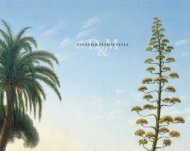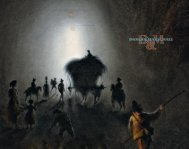Catalogue 2010 - daxer & marschall
Catalogue 2010 - daxer & marschall
Catalogue 2010 - daxer & marschall
Create successful ePaper yourself
Turn your PDF publications into a flip-book with our unique Google optimized e-Paper software.
CHARLES HOGuET<br />
A Pumpkin on a Cane-Seated Chair<br />
Charles Hoguet<br />
(1821 - Berlin - 1870)<br />
A Pumpkin on a Cane-Seated Chair,<br />
1853<br />
Oil on canvas<br />
Signed and dated C. Hoguet 1853<br />
99 x 65.5 cm<br />
Provenance:<br />
N. J. Oppenheimer, Sweden 1<br />
48<br />
Charles Hoguet 2 studied in Paris. By the 1850s he had come to rank alongside Adolph Menzel<br />
(1815-1905) as one of the few still life painters of international standing in Germany. As his subjects<br />
he chose simple objects, vegetables, kitchen utensils, dead game and humble household objects.<br />
His realism was highly distinctive and was undoubtedly inspired by the work of Gustave Courbet<br />
(1819-77) who played a decisive role in revolutionizing genre painting. 3<br />
A Pumpkin on a Cane-Seated Chair is one of a group of variations on a similar subject executed<br />
in the mid-1850s. A related version is in the collection of the Alte Nationalgalerie in Berlin. 4 Here<br />
too, the subject matter is emphatically reduced and the composition focusses on a pumpkin, a knife,<br />
a chair and a cloth set against a uniform black-brown background.<br />
Hoguet was born in Berlin and came of Huguenot stock. He was in close contact with<br />
members of the French colony in the city. He studied marine painting in 1839 under the Berlin artist<br />
Wilhelm August Krause (1803-64). In 1840-3, continuing his studies in Paris, he was associated with<br />
Eugène Cicéri (1813-90) and Eugène Isabey (1804-86). The award of a gold medal, albeit second<br />
class, at the Paris Salon in 1848 brought him considerable public acclaim. He decided to return to<br />
Berlin permanently but continued to travel extensively on study tours in France, the Netherlands,<br />
England and Scotland right up to the end of his life.<br />
He began work on a inventory of his own extensive œuvre in 1859. His paintings are held in<br />
leading collections throughout Germany. Seven alone were in the possession of the Nationalgalerie<br />
in Berlin, however only one survived the bombing in World War II. He also produced landscapes<br />
and marine paintings but his real strength lay in the still life genre. He reached the peak of his<br />
artistic powers in the period around 1850-60.<br />
1. Oppenheimer was a leading collector and painter of still lifes. He was known as Jonny Hoppenheimer (1923-2008).<br />
2. Literature: Egbert Lammers, Charles Hoguet. Ein Beitrag zur Berliner Kunstgeschichte im 19. Jahrhundert, Berlin 1933 (Diss., university of<br />
Bonn, 1931); id., ‘Charles Hoguet. 1821-1870’, in: Zeitschrift für Kunstgeschichte II, 1933, pp. 279-89; Irmgard Wirth, Berliner Malerei im<br />
19. Jahrhundert, Berlin 1990, pp. 370- and p. 376, fig. 477; Helmut Börsch-Supan, Die Deutsche Malerei von Anton Graff bis Hans von Marées<br />
1760-1870, Munich 1988, pp. 85, 328, 336 and 498.<br />
3. The Düsseldorf artist Johann Wilhelm Preyer (1803-89) specialized in conservative still lifes. His precise style of execution was guided<br />
by Dutch baroque painting.<br />
4. A Pumpkin on a Cane-Seated Chair, 1853, Alte Nationalgalerie, SMPK, Berlin; Still Life with a Cat, 1857, Raehmel Collection, Berlin<br />
(see E. Lammers in Zeitschrift für Kunstgeschichte II, 1933, fig. 7).






